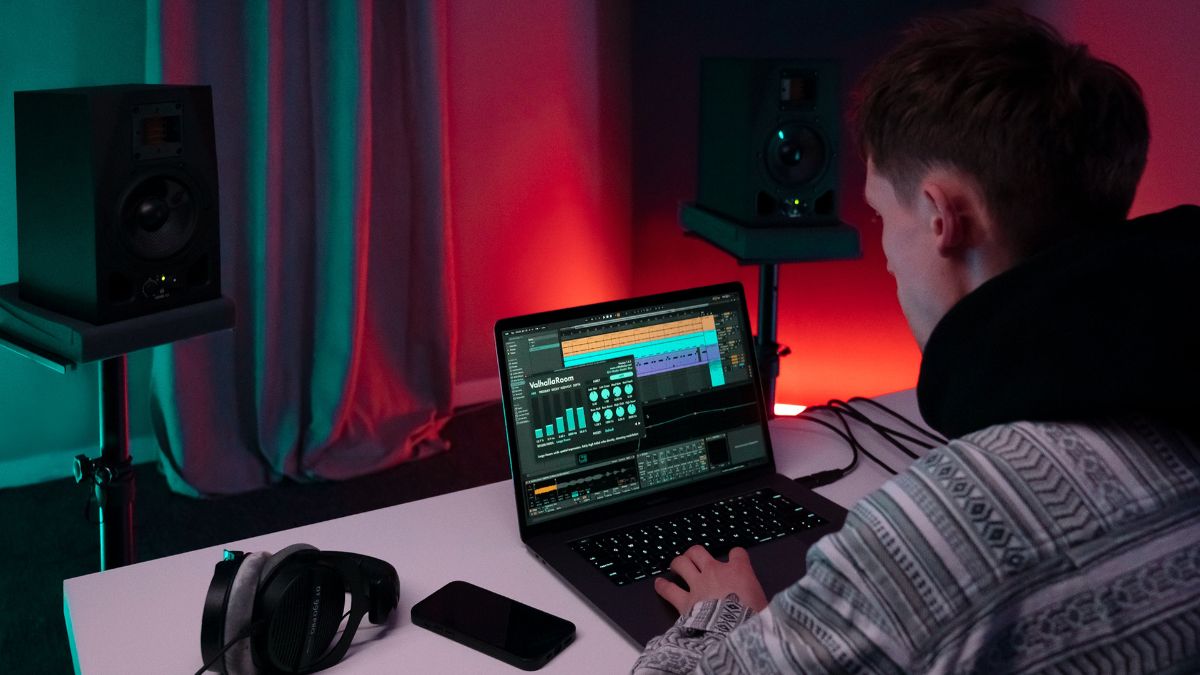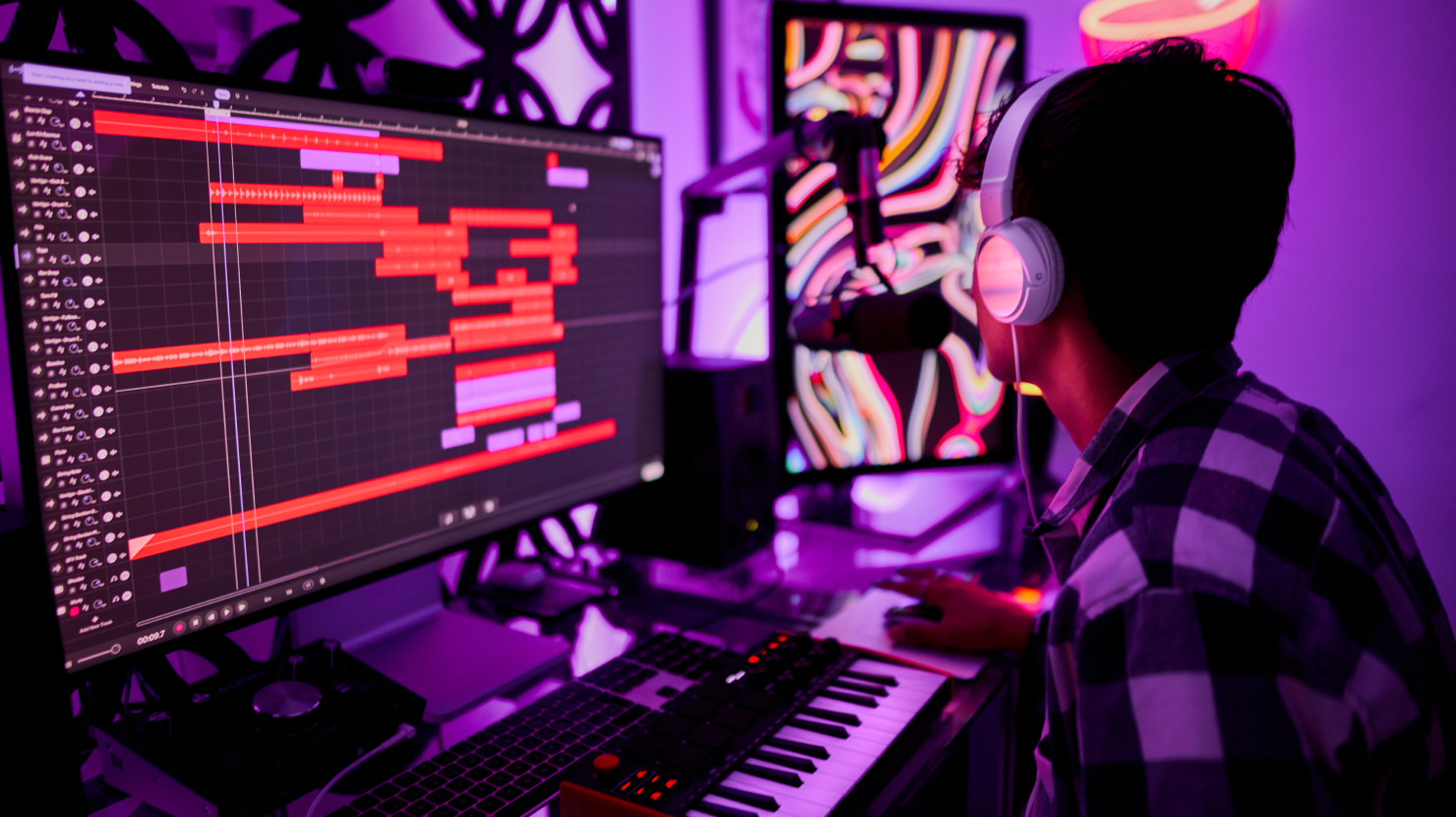Home>Production & Technology>Remix>How To Make A Hardstyle Remix


Remix
How To Make A Hardstyle Remix
Modified: February 19, 2024
Learn how to create an electrifying hardstyle remix with step-by-step instructions. Master the art of remixing and take your tracks to the next level.
(Many of the links in this article redirect to a specific reviewed product. Your purchase of these products through affiliate links helps to generate commission for AudioLover.com, at no extra cost. Learn more)
Table of Contents
- Introduction
- Step 1: Choose a Hardstyle Track
- Step 2: Gather the Necessary Tools
- Step 3: Analyze the Original Track
- Step 4: Create a Basic Structure
- Step 5: Generate a Kick & Bassline
- Step 6: Add Melodic Elements
- Step 7: Incorporate Build-ups and Breakdowns
- Step 8: Enhance the Sound Design
- Step 9: Arrange the Remix
- Step 10: Mix and Master the Remix
- Conclusion
Introduction
Are you a music producer with a passion for hardstyle music? Have you ever listened to a hardstyle track and thought, “I could put a unique spin on this”? Well, you’re in luck! In this article, we will guide you through the process of creating a hardstyle remix that will blow away your audience.
Remixing has become increasingly popular in the digital music era, allowing artists to reimagine and reinterpret existing tracks to give them a fresh and innovative sound. Hardstyle, with its energetic beats and powerful melodies, is a genre that lends itself well to remixing. By following these step-by-step instructions, you’ll be able to transform a hardstyle track into your own unique creation.
Before we dive into the process, it’s important to note that remixing is both an art and a technical skill. It requires a deep understanding of the original track, as well as knowledge of the tools and techniques needed to produce high-quality remixes. So, let’s get started on your journey to becoming a hardstyle remix master!
Step 1: Choose a Hardstyle Track
The first step in creating a hardstyle remix is selecting the right track to work with. Choosing a track that inspires you and resonates with your creative vision is essential. Look for tracks that have a solid foundation, catchy melodies, and an overall sound that matches your remixing style.
When selecting a track, consider the following:
- Popularity: Choose a track that has a significant following and has the potential to reach a large audience. Remixing a popular hardstyle track can help attract attention to your work and gain recognition in the hardstyle community.
- Compatibility: Ensure that the chosen track aligns with your musical genre and style. While remixing is about adding your own elements, it is essential to maintain the core characteristics of hardstyle music.
- Availability: Make sure that the original track is accessible for remixing. Check if the artist or record label has given permission for remixes or if the track has been released under a Creative Commons license.
Once you have chosen a track, listen to it multiple times to familiarize yourself with its structure, elements, and overall vibe. Take notes on specific sections that stand out to you, such as the drop, breakdown, or any memorable hooks. This will help guide your remixing process and give you a clear direction to follow.
Remember, the goal of a remix is to add your own creative touch to the original track while still paying homage to the original artist’s work. So, choose a track that you connect with and feel inspired to put your unique spin on.
Step 2: Gather the Necessary Tools
Before diving into the remixing process, it’s important to ensure you have the right tools at your disposal. Having the necessary software, plugins, and sample packs will make the remixing process smoother and more efficient. Here are some essential tools you’ll need:
- Digital Audio Workstation (DAW): Choose a DAW that you are comfortable working with. Popular options for hardstyle remixing include FL Studio, Ableton Live, and Logic Pro. Each DAW has its own unique features and workflow, so choose the one that best suits your style and preferences.
- Sample Packs: Hardstyle remixes often require specific drum samples, kick drums, basslines, and synths. Look for high-quality hardstyle sample packs that offer a wide range of sounds and elements. Some popular sample pack providers include Loopmasters, Prime Loops, and Sample Magic.
- Plugins and Virtual Instruments: Invest in plugins and virtual instruments that cater to hardstyle music production. Look for plugins that specialize in creating hard-hitting kicks, intense basslines, and atmospheric effects. Popular plugins for hardstyle production include Sylenth1, Serum, and Harmor.
- MIDI Controllers: While not mandatory, having a MIDI controller can greatly enhance your workflow and creative expression. MIDI keyboards and pads allow you to play and manipulate virtual instruments in real-time, giving you a more hands-on approach to music production.
- Sound Libraries: Expand your sonic arsenal by gathering a collection of high-quality sound libraries or sound banks. These can include presets for synths, effects, and sample loops specifically designed for hardstyle music.
Once you have gathered all the necessary tools, take the time to familiarize yourself with them. Explore and experiment with the various plugins, sample packs, and virtual instruments to fully understand their capabilities and how they can contribute to your remix.
By ensuring that you have the right tools in place, you’ll be well-prepared to embark on the journey of creating an incredible hardstyle remix.
Step 3: Analyze the Original Track
Once you have selected a hardstyle track to remix and gathered the necessary tools, it’s time to analyze the original track. Understanding the structure, arrangement, and key elements of the original track is crucial for creating a successful remix. Here’s how to analyze the original track effectively:
- Listen Carefully: Start by listening to the original track multiple times. Pay attention to the different sections, such as the intro, build-up, drop, breakdown, and outro. Take note of the arrangement, transitions, and overall energy of the track.
- Identify Key Elements: Identify the key elements that define the track, such as the main melody, bassline, and percussive elements. Note any unique sound design elements, effects, or vocal samples that give the track its distinctive character.
- Structure and Arrangement: Analyze the structure and arrangement of the original track. Identify how many bars are in each section and the overall progression of the track. Pay attention to where key elements are introduced, how the energy builds, and where the climactic moments occur.
- Emotional and Musical Elements: Take note of the emotional and musical elements present in the track. Identify the harmonic progressions, chord patterns, and any melodic or harmonic variations. This will give you insights into the musical elements that make the original track captivating.
- Sound Design: Listen closely to the sound design of the original track. Note the characteristics of the kick drum, bassline, and synth sounds. Pay attention to the use of effects, modulation, and spatial positioning to create depth and movement in the mix.
By thoroughly analyzing the original track, you’ll gain a deep understanding of its structure, key elements, and overall vibe. This knowledge will serve as a foundation for creating your remix, allowing you to incorporate your own unique ideas while still respecting the essence of the original track.
Keep your analysis notes handy throughout the remixing process as a reference point. This will help you stay on track and make informed decisions when it comes to arranging, sound design, and adding your personal touch to the remix.
Step 4: Create a Basic Structure
Now that you have analyzed the original track and gained insights into its structure and key elements, it’s time to create a basic structure for your remix. Establishing a solid framework will provide a roadmap for the rest of the remixing process. Follow these steps to create a basic structure:
- Break Down the Original Track: Divide the original track into its different sections, such as the intro, verse, chorus, breakdown, and outro. Take note of the number of bars in each section and the transitions between them.
- Plan Your Remix Structure: Determine how you want to structure your remix. Will you follow a similar arrangement to the original track, or do you want to create a completely new arrangement? Consider introducing variations, additional sections, or rearranging elements to give your remix a fresh and unique perspective.
- Identify Key Elements to Retain: Identify the key elements from the original track that you want to retain in your remix. This could be the main melody, vocal hooks, or certain sound design elements that define the track. These elements will serve as anchor points in your remix.
- Build Your Remix’s Sections: Start arranging your remix by building each section based on the structure you planned. Begin with the intro and gradually introduce elements leading up to the main drop. Experiment with variations and different combinations of elements to add your own creative twist.
- Create Transitions: Pay attention to creating smooth transitions between sections. Use effects, fills, and automation to seamlessly transition between different parts of the remix. This will help maintain the flow and energy of the track.
- Consider the Energy Flow: Keep the energy flow in mind as you structure your remix. Aim to build anticipation and excitement leading up to the main drop, and introduce moments of contrast and release in the breakdowns or build-ups. This will give your remix a dynamic and engaging feel.
Remember, while creating a basic structure, you don’t need to finalize every detail at this stage. The goal is to establish a rough outline that can be refined and developed further in the subsequent steps.
By creating a basic structure for your remix, you’ll have a clear roadmap to follow, enabling you to focus on refining and adding your own creative elements to make the remix truly shine.
Step 5: Generate a Kick & Bassline
A strong kick drum and a powerful bassline are essential components of any hardstyle remix. These elements provide the foundation and drive of the track. In this step, we’ll focus on generating a kick and bassline that will make your remix stand out. Follow these guidelines to create an impactful kick and bassline:
- Choose or Create a Kick: Select a hard-hitting kick sound that suits your remix. You can choose from pre-made sample packs or design your own kick using synthesis techniques. Ensure that the kick has a clean and punchy sound with a strong low-end presence.
- Layer and Process the Kick: To make your kick stand out, consider layering it with additional samples or adding distortion to enhance its impact. Experiment with EQ, compression, and saturation to shape the kick’s tone and dynamics. Pay attention to the balance between the kick and the rest of the mix.
- Create a Solid Bassline: Start by designing a bassline that complements the kick and adds depth to your remix. Experiment with different synth sounds and techniques to create a bassline that is both melodic and powerful. Pay attention to the timing and rhythm of the bassline to ensure it syncs well with the kick.
- Add Sub-Bass: Layer a sub-bass element below your main bassline to enhance the low-frequency presence. The sub-bass should reinforce the kick and provide weight to the overall mix. Make sure it sits well in the mix and doesn’t overpower other elements.
- Process the Bassline: Apply processing techniques like EQ, compression, and saturation to shape the bassline’s tone and ensure it cuts through the mix. Experiment with modulation effects, such as filtering or phasing, to add movement and interest to the bassline.
- Ensure Cohesion: Pay attention to the relationship between the kick and the bassline. They should work together to create a tight and well-defined low-end. Adjust the levels and frequencies of each element to achieve a balanced and cohesive sound.
Remember, the kick and bassline are the driving force behind a hardstyle remix. Invest time and effort in crafting a powerful kick and bassline that work harmoniously together to deliver a solid foundation for your track.
Once you’ve generated a compelling kick and bassline, you’ll have a strong backbone that will set the tone for the rest of your remix.
Step 6: Add Melodic Elements
Now that you have a solid foundation with the kick and bassline, it’s time to add melodic elements to your hardstyle remix. Melodies play a crucial role in creating the mood, emotion, and hooks that make a remix memorable. Follow these steps to add captivating melodic elements:
- Identify the Key Elements from the Original Track: Recall the key melodic elements from the original track that you decided to retain in your remix. These could be catchy hooks, memorable melodies, or unique synths. Consider how you can incorporate these elements into your remix while still adding your own creative touch.
- Create Original Melodies: Develop new melodic ideas that complement the existing melodic elements or stand on their own. Use virtual instruments, synths, or sample libraries to create unique and engaging melodies. Experiment with different scales, chord progressions, and rhythmic patterns to add variety and interest.
- Layer and Harmonize: Layer different melodies to create depth and richness in your remix. Experiment with harmonizing melodies, creating counter-melodies, or using arpeggios to add complexity. Ensure that the melodies work together harmonically and don’t clash with each other.
- Explore Sound Design: Pay attention to the sound design of your melodic elements. Use effects like reverb, delay, and modulation to add depth and space. Experiment with different timbres, textures, and articulations to make your melodies stand out.
- Create Variation: Avoid monotony by introducing variations in your melodic elements. Add variations in note sequences, rhythm, or articulation to keep the listener engaged. Consider using automation to create build-ups, drops, or breakdowns in your melodies.
- Balance and Mix: Ensure that your melodic elements sit well in the overall mix and don’t overpower other elements like the kick, bassline, or vocals. Use EQ, compression, and panning to achieve a balanced and cohesive sound. Pay attention to the frequency range of each melodic element to prevent clashes.
By adding compelling and memorable melodies to your hardstyle remix, you’ll create hooks that resonate with your listeners and keep them coming back for more. Let your creativity flow and experiment with different melodic ideas until you find the perfect balance for your remix.
Remember, the melody is the soul of a track. Aim to create melodic elements that are not only catchy but also emotionally impactful, and watch as your hardstyle remix takes on a life of its own.
Step 7: Incorporate Build-ups and Breakdowns
Build-ups and breakdowns are crucial elements in a hardstyle remix, as they help create tension, anticipation, and dramatic moments in the track. In this step, we’ll focus on incorporating build-ups and breakdowns to enhance the dynamic and impactful nature of your remix. Follow these steps:
- Plan the Build-up: Decide where you want to place build-ups in your remix. Typically, build-ups occur before the drop, serving as a transition from the calmer sections to the high-energy climax. Consider using effects, risers, or vocal samples to build tension and excitement leading up to the drop.
- Effect and Automation: Experiment with different effects, such as filters, delays, or reverbs, to create a sense of anticipation and movement during the build-up. Use automation to gradually increase the intensity of certain elements, such as the kick drum, bassline, or synths, as you approach the drop.
- Climactic Moment: Build up to a climactic moment just before the drop. This could involve a pause, a drum fill, or an impactful sound effect to create maximum impact and anticipation. Make sure the drop that follows is explosive and instantly grabs the listener’s attention.
- Develop the Breakdown: Breakdown sections offer an opportunity to create contrast and introduce different elements to the track. Experiment with stripping down the arrangement or introducing new melodic elements, pads, or atmospheric effects to add depth and create a sense of anticipation for the next build-up or drop.
- Consider Breakdown Variations: Use variations in your breakdown sections to maintain interest and avoid repetition. This could involve changing the chord progression, introducing vocal snippets, or adding atmospheric elements to create intrigue and engage the listener.
- Focus on Transitions: Pay close attention to the transitions between different sections, including build-ups, breakdowns, and drops. Use effects, risers, or drum fills to create smooth and seamless transitions. This will help maintain the flow and energy of your remix.
By incorporating well-executed build-ups and breakdowns, you will elevate the anticipation and excitement in your hardstyle remix. These sections add depth, contrast, and impact, keeping your listeners engaged throughout the track.
Take your time to experiment with different techniques and elements to create build-ups and breakdowns that perfectly complement the overall vibe of your remix. Remember, these sections are your chance to create tension and deliver those jaw-dropping moments that will make your remix truly unforgettable.
Step 8: Enhance the Sound Design
Sound design is an integral part of creating a captivating hardstyle remix. It involves shaping and manipulating the individual sounds in your track to take them to the next level. In this step, we’ll explore techniques to enhance the sound design of your remix. Follow these steps to create a rich and engaging sonic experience:
- Experiment with Effects: Utilize a wide range of effects to add depth, dimension, and movement to your sounds. Try using reverb, delay, chorus, distortion, and modulation effects to achieve unique textures and sonic characteristics.
- Create Custom Patches: Customize your synths and virtual instruments by creating unique patches or modifying existing presets. Tweak parameters such as oscillators, filters, envelopes, and LFOs to shape the sound and make it stand out.
- Add Atmospheric Elements: Incorporate atmospheric sounds, such as pads, textures, or ambient samples, to create a sense of space and immersion in your remix. These elements can add depth and richness, enhancing the overall vibe of the track.
- Layer Sounds: Layering sounds can add thickness and complexity to your mix. Experiment by combining different sounds or instruments to create unique textures and harmonies. Ensure that the layers work together harmonically and don’t clash with each other.
- Experiment with Modulation: Use modulation techniques to introduce movement and variation in your sounds. Try using techniques like frequency modulation, amplitude modulation, or modulation effects to add interest and dynamics to your remix.
- Consider Foley and Field Recordings: Incorporate foley sounds or field recordings to add organic and realistic elements to your track. These can be everyday sounds or recordings you create specifically for your remix. These unique sounds can add character and authenticity to your remix.
- Layer Drum Hits and Percussion: Enhance the impact and depth of your drum programming by layering different drum hits and percussion samples. Experiment with combining different samples to achieve a unique and powerful drum sound.
- Apply Automation: Use automation to add movement, modulation, and expression to your sounds. Automate parameters such as cutoff, resonance, pan, or volume to create evolving and dynamic elements within your remix.
By paying attention to the sound design of your remix, you’ll create a more immersive and engaging listening experience for your audience. Experiment with various techniques and let your creativity guide you in shaping sounds that are unique to your remix.
Remember, sound design is an ongoing process, and it’s important to regularly tweak and refine the elements in your remix to achieve the desired sonic impact. Don’t be afraid to step outside the box and push the boundaries of what’s possible in your sound design.
Step 9: Arrange the Remix
Once you have completed the sound design and have all the elements in place, it’s time to arrange your hardstyle remix. Arrangement plays a crucial role in shaping the overall structure and flow of your track. Follow these steps to effectively arrange your remix:
- Establish the Intro: Begin your remix with an engaging and attention-grabbing intro. Create an atmosphere that sets the tone for the rest of the track and hooks the listener from the start. Consider using elements from the original track or introducing new elements to make your intro unique.
- Structure the Verses and Choruses: Develop the verses and choruses of your remix, maintaining a balance between familiarity and your unique creative elements. Experiment with layering and variations to give each section its own identity, while still keeping an overall cohesive sound.
- Build and Release Energy: Use build-ups, breakdowns, and drops strategically to create energy and excitement in your remix. Gradually increase intensity leading up to the drop, providing moments of release and contrast in the breakdowns.
- Add Transitions: Focus on creating smooth transitions between different sections of your remix. Use effects, risers, drum fills, or filter sweeps to seamlessly move between different parts of the track. Ensure that the transitions maintain the energy and flow of your remix.
- Include Breaks or Interludes: Consider inserting breaks or interludes throughout your remix to provide moments of respite and allow the elements to stand out. These breaks can also create anticipation for the next section or build-up, adding anticipation and interest to your track.
- Experiment with Arrangement Variation: To keep your remix engaging, try introducing variations in the arrangement. This could involve removing certain elements, adding new layers, or altering the progression of sections. These variations will keep the listener engaged and prevent the track from becoming predictable.
- Conclude with an Outro: Wrap up your remix with a well-crafted outro that slowly fades out or provides a moment of resolution. Ensure that the outro is consistent with the overall vibe of your remix and leaves a lasting impression on the listener.
During the arrangement process, trust your instincts and follow your creative vision. Experiment with different sections, transitions, and variations until you achieve a remix that is coherent, dynamic, and memorable.
Remember, arranging is an art that requires careful consideration of the flow and structure of your remix. Take the time to fine-tune and refine the arrangement to ensure that each section complements the next, creating a cohesive and impactful experience for your audience.
Step 10: Mix and Master the Remix
Once you have arranged your hardstyle remix, it’s time to focus on the final stages of the production process: mixing and mastering. These steps are crucial in ensuring that your remix sounds polished, balanced, and professional. Follow these steps to effectively mix and master your remix:
- Mixing: Start by organizing your tracks and ensuring everything is properly labeled and grouped. Begin balancing the levels of each element in your mix, paying attention to the relationship between the kick, bassline, melodies, and other sounds. Use EQ to carve out space for each element, addressing any frequency clashes.
- Panning and Stereo Width: Utilize panning to create a spacious and wide stereo image. Place elements strategically to give a sense of depth and width in your mix. Experiment with stereo enhancement techniques, such as stereo wideners or stereo separation, to add dimension to your remix.
- Dynamics and Compression: Apply compression to control the dynamic range of individual tracks and create a more balanced sound. Use dynamic processing techniques like sidechain compression to create space for the kick, allowing it to cut through the mix. Ensure that the overall mix maintains a good balance between loudness and dynamics.
- Add Effects and Spatialization: Enhance your mix with effects such as reverb, delay, and modulation. Apply these effects to create depth, space, and movement. Experiment with different settings to find the right balance and make sure the effects enhance the overall atmosphere of your remix.
- Level and Loudness: Ensure that the overall mix has an appropriate level of loudness, taking into consideration the intended musical genre and industry standards. Use a limiter with caution to achieve a competitive volume level, being mindful of not over-compressing or squashing the dynamics of your remix.
- Mastering: Once you are satisfied with the mix, move on to the mastering stage. Apply subtle EQ adjustments to enhance the overall tonal balance of the track. Use a multiband compressor or a mastering compressor to further tame the dynamics and control the overall loudness. Be careful not to over-process or deplete the dynamics of your mix. Aim for a well-balanced and cohesive sound.
- Quality Check and A/B Testing: Take breaks and return to your mix with fresh ears. Conduct thorough quality checks, listening to your remix on different playback systems and reference tracks. Perform A/B testing to compare the sound of your remix with professionally mixed and mastered tracks in the same genre.
The mix and master stages are crucial for achieving a professional and polished sound in your hardstyle remix. Pay attention to detail, take the time to fine-tune and make adjustments until you are satisfied with the final result.
Remember, the goal of mixing and mastering is to ensure that your remix translates well across different listening environments and captures the essence of the hardstyle genre, delivering a powerful and impactful sonic experience to your audience.
Conclusion
Congratulations! You have completed the journey of creating a hardstyle remix. Throughout the process, you have learned how to select the right track, gather the necessary tools, analyze the original track, create a basic structure, generate a kick and bassline, add melodic elements, incorporate build-ups and breakdowns, enhance the sound design, arrange the remix, and finally, mix and master the track.
Remixing is a creative and technical endeavor that requires both skill and artistry. By following these steps, you have gained the knowledge and techniques necessary to craft a compelling and unique hardstyle remix.
Remember to approach each step with passion, experimentation, and attention to detail. Embrace your creativity, trust your instincts, and allow your unique style to shine through. Don’t be afraid to deviate from the original track and add your personal touch to make the remix truly your own.
Throughout the process, keep refining and honing your skills. Continually learn and explore new techniques to push the boundaries of your remixing abilities. With time and practice, you will grow as a producer and become even more adept at creating your signature hardstyle sound.
Lastly, share your hardstyle remix with the world. Publish it on music platforms, share it with your community, and gather feedback. Embrace both praise and constructive criticism as opportunities for growth and improvement.
Now, armed with the knowledge and skills you have acquired, it’s time for you to go out and create remarkable hardstyle remixes that will captivate audiences and establish your presence in the music industry. So, put on your producer hat, fire up your DAW, and let the remixing magic begin!











